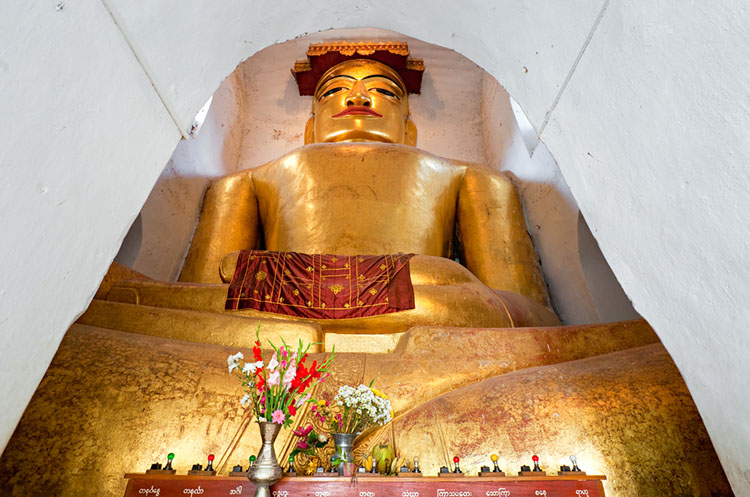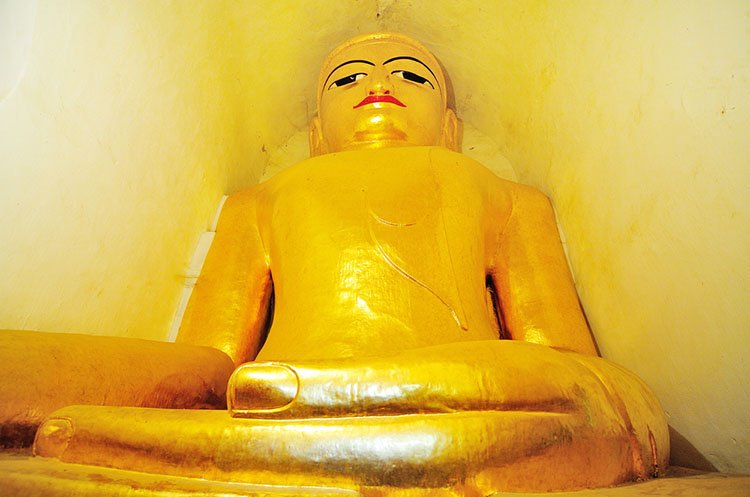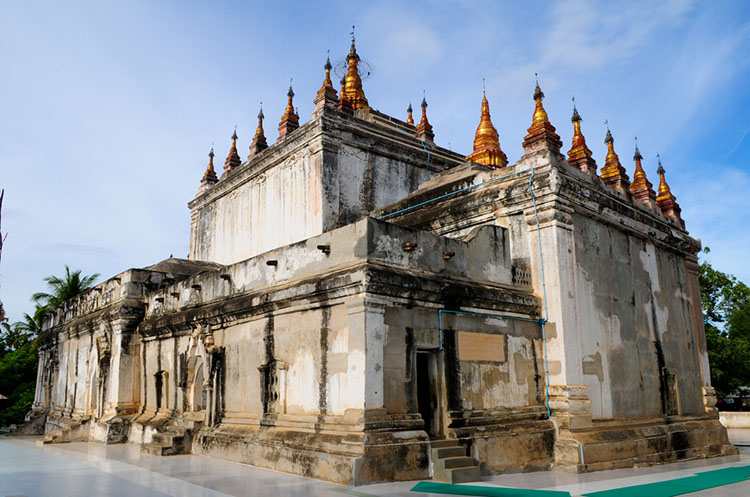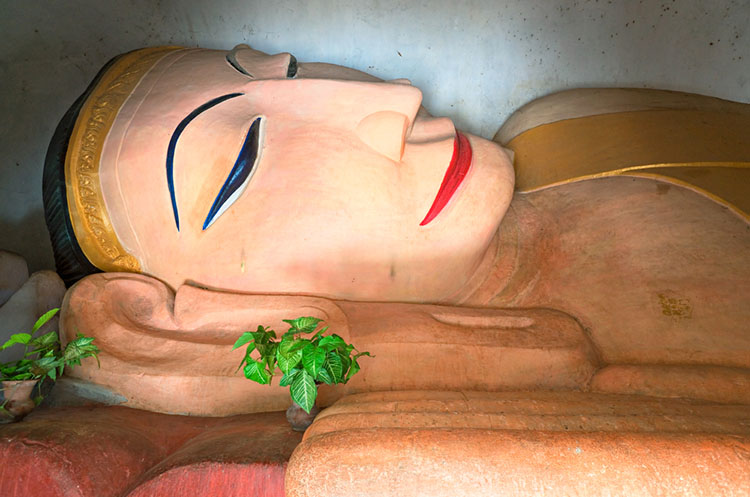
Manuha temple
One of the oldest temples in Bagan enshrining 4 large Buddha images
Off Bagan - Chauk road between old Bagan and new Bagan
The Manuha temple is one of the oldest temples of Bagan. It is named after Manuha, King of a Mon Kingdom named Thaton located in lower Burma. Manuha built the temple in 1067, after having spend a decade in captivity in Bagan.
Four large golden Buddha images
The temple enshrines four large gold painted images of the Buddha, each contained within a separate room, barely large enough to accommodate the images.
The front of the temple consists of three rooms, each containing a seated image. The central image measuring 46 feet high is in the “Calling the Earth to witness” posture. It is flanked by two smaller images each 33 feet high. The back of the building consists of a single room, that contains a 90 feet long reclining Buddha image wearing a serene facial expression.
To this day, the Manuha temple is an active place of worship for Burmese Buddhists.

Structure of the Manuha temple
The Manuha temple is a rectangular, whitewashed building. The top storey which is much smaller than the lower one is topped with a large multi tiered hti, a spire shaped like a ceremonial umbrella. The edges of both first and second storey are adorned with several smaller hti’s.
The building is oriented towards the East. At the center is a portico with the main entrance protruding out of the structure leading to the room that contains the largest sitting Buddha image. Two smaller entrances on either side of the portico lead to the rooms enshrining the smaller images.
Reclining Buddha
A number of narrow steps and a narrow door lead towards the room of the reclining Buddha in the back of the structure. Near the back is a stairway to the top of the temple; a window allows a view of one of the huge seated images from above. During the 1975 earthquake part of the roof collapsed damaging the central image, which has been restored since.

History of the Manuha temple
The stone inscription found at the temple tells the storey of the Manuha temple and the Buddha images enshrined in it.
Anawrahta, King of Bagan wanted to further Buddhism in his empire. He requested Manuha, King of the Mon Kingdom Thaton a copy of the Tripitaka, the Buddhist teachings. After Manuha refused, King Anawrahta invaded Thaton in 1057. King Manuha was captured, taken back to Bagan and imprisoned. Also captured were thousands of Mon artisans and craftsmen, that played an important role in the building of countless temples in Bagan during the next decades.
After having spend 10 years in captivity, Manuha wanted to gain religious merit as he wanted to attain Nirvana. He also wished that during the cycle of rebirths (Samsara), he would never be conquered by enemies and had to live in captivity again. He therefore request Anawrahta permission to build a temple.
Since the captured King did not have the money to build a temple, he sold a precious jewel to a rich Myinkaba merchant for six cart loads of fine silver. The King used the silver to pay for the construction of a large image of the Buddha, in which Buddhist relics were enshrined. Later he had three more images build. After the completion of the four images, the temple was built around them. The rooms are barely large enough to contain the four images; It is believed that Manuha wanted to express his frustration about his captivity.

Other structures on the grounds
A recent Burmese style building next to the temple contains statues of King Manuha and his Queen as well as an enormous alms bowl with a ladder in front of it. On a pole next to the temple rests a legendary Hamsa bird.
A section of a hall contains very colorful images of three of Burma’s most venerated Nats, Mai Wunna and her two sons, who live on Mount Popa, about fifty kilometers from Bagan. The Nats are ancient spirits that have been worshipped in Burma even before the arrival of Buddhism.
Near the temple is a small chedi topped with a hti.
Getting to the temple
Other temples in Bagan
Among the other temples & pagodas in Bagan are:
- Shwezigon pagoda
- Ananda pagoda
- Gawdawpalin temple
- Sulamani temple
- Thatbyinnyu temple
- Seinnyet sister temples
- Bupaya pagoda
- Mahabodhi temple
- Htilominlo temple
- Mingalazedi pagoda
- Dhammayazika pagoda
- Dhammayangyi temple
- Lawkananda pagoda
- Pyathadar temple
- Pahtothamya temple
- Myazedi pagoda
- Shwesandaw pagoda
- Gubyaukgyi temple
History
How to get to Bagan and how to get around
- Shwezigon pagoda
- Ananda pagoda
- Gawdawpalin temple
- Sulamani temple
- Thatbyinnyu temple
- Seinnyet sister temples
- Bupaya pagoda
- Mahabodhi temple
- Htilominlo temple
- Mingalazedi pagoda
- Dhammayazika pagoda
- Dhammayangyi temple
- Lawkananda pagoda
- Manuha temple
- Pyathadar temple
- Pahtothamya temple
- Myazedi pagoda
- Shwesandaw pagoda
- Gubyaukgyi temple